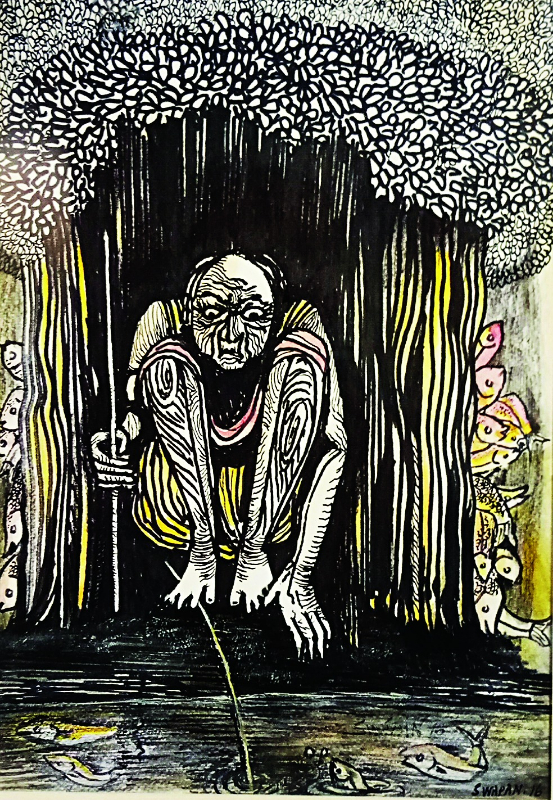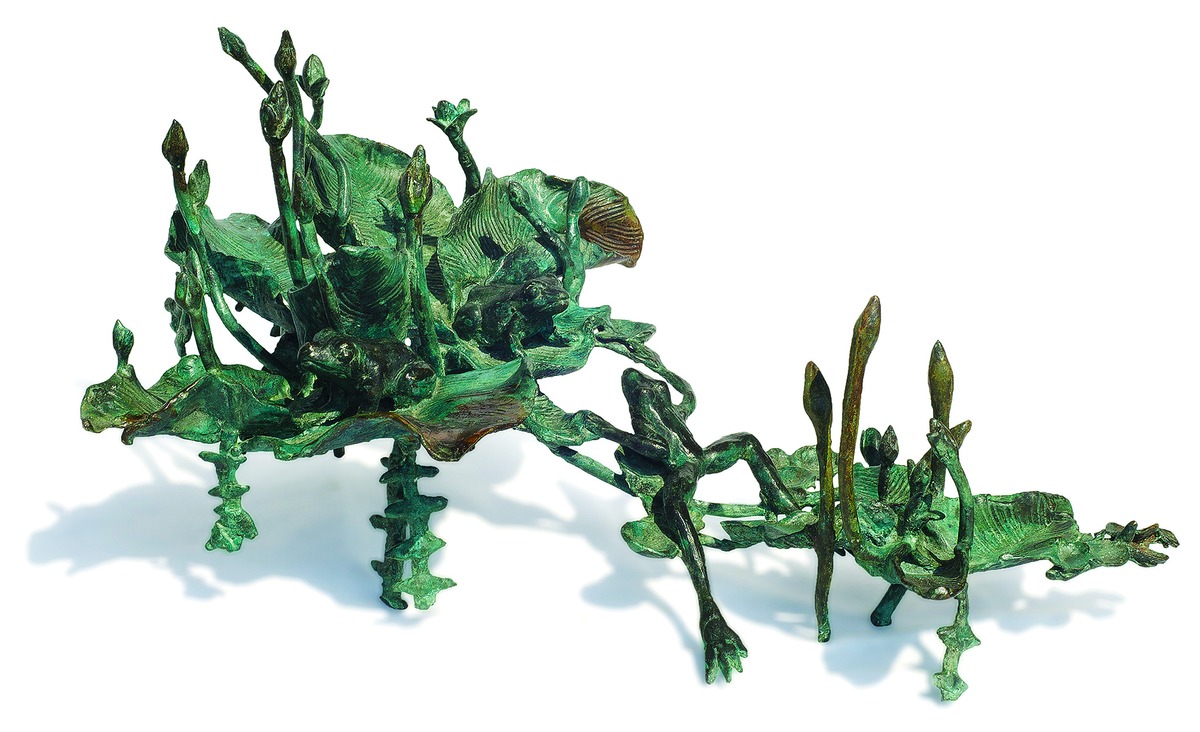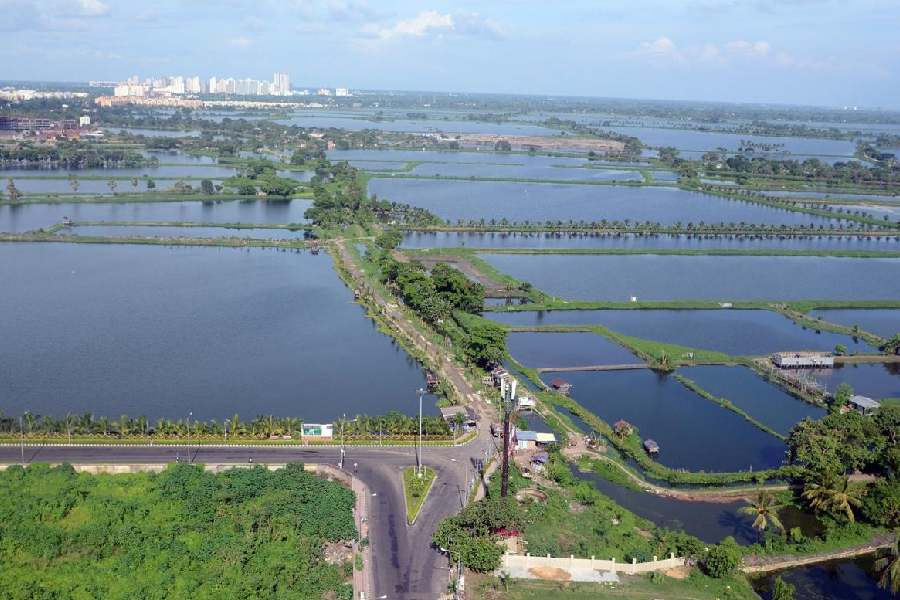At the gallery entrance, there was a watercolour of a girl sitting by a pond, her feet in the blue waters. She is feeding a badling of ducks out of an aluminium vessel. The title of the painting is, 'A village girl is eating her own pet ducks.'
When we meet the artist, who is in his early 30s, we ask him about the title. 'It is a fact,' says Satyabrata Karmakar. And adds, 'People there have to eat what they rear.'
Satyabrata is member of an artists' group called Mangrove. In 2015, three of them - Swapan Kumar Mondal, Arup Kumar Mondal and Khokon Raut - came together to form it. Says Swapan, 'Our aim was to create a cultural identity for us - the 45 lakh people living in the Sunderbans. We wanted the rest of the world to know how we have to fight nature to survive in that geography. And that is why we named our group Mangrove.' Today, the group has 15 members.
Unlike the other artists at the gallery that day, Swapan is not dressed in kurta-pyjama. He is dressed in a dark suit and hat. 'Do not go by my appearance,' he says. 'The images of the Sunderbans are etched in my heart. Nothing can erase those.'
On canvas, Swapan needs no camouflage for survival. One of his paintings is titled 'Fishing in the last phase'. It stands out from the rest of the exhibits.
Using only two prominent colours - black and yellow, Swapan has painted an old woman fishing. Her face grotesque and lined, her eyes are glued to the water waiting for the fish to take the bait. Yet another canvas shows a woman rowing a boat. Framing the scene is dense foliage and a button moon. There is a stove on the deck and on it is a lone pot.
Swapan narrates how after Aila, the cyclone in 2007, the men of the region moved out in search of livelihood. They travelled to Bangalore, Delhi, Ahmedabad, the Andamans and Tamil Nadu, leaving the women to fend for themselves. 'And now women rule the Sunderbans,' he says. 'They go out fishing, steering the boats through the estuaries. Sometimes, when they know they have to be out overnight, they take their children. In my painting, I have tried to celebrate these women.'
This is also true of the paintings of Arup.

Swapan Kumar Mondal's Fishing in the last phase
Arup is the son of a farmer, has spent his childhood in the Chhota Mollakhali village of Marichjhapi island in the Sunderbans. He says, 'I have grown up working in muddy waters. There was no road, no transport, no electricity. People used to depend heavily on the forest for a living.'
Arup's paintings are also about the lives of fishermen and women.
'I have seen women being dragged away by crocodiles while they were gathering prawn seeds in the river. I have seen tigers attack local people who go to collect honey in the forest,' says Rajat Baran Mahapatra, a self-trained artist who has joined the group recently.
His paintings are full of stylised Sunderbans fauna - tigers, prawns, owls. He uses deep reds, deep blues and bright yellows.

Mrinal Kanti Gayen's childhood memories come alive in his painting.
Whenever we talk about the Sunderbans, we talk about Royal Bengal tigers, about vast stretches of riverine delta stitched up by tributaries and distributaries, of dense mangrove forests, of unspoken levels of poverty. That is indeed, the outsider's impression of the Sunderbans. Recently, however, we got an insider view, quite literally.
A group of artists from the Sunderbans put up an exhibition at the Academy of Fine Arts in Calcutta.
Mrinal Kanti Gayen is also participating in the exhibition. Currently, a professor at the Government College of Art and Craft, Calcutta, he has a sculpture on display here. He says, 'I have spent a part of my childhood in Dakshin Kashiabad of Kakdweep. My friends and I had to take a boat to go from one island to another just to attend school. We had to cross creaky wooden bridges on the waters infested with reptiles.' These man-made bridges, he explains, would disappear every year during the monsoons.
He continues, 'As a child, I remember how our primary school used to be held under a peepal tree by a pond. I still remember how the trees skirting the pond would bend low over the water, almost merging with their own reflections. In the shadows of the trees, I would spot fish playing and toads jumping, even as children frolicked on the banks.' His sculpture is a representation of this scene from his childhood.
Young artist Avik Modak, too, has tried to capture nature's plenty.
On the whole, the exhibition attempts to put out a slice of rural life before an urban audience. Swapan says, 'People travel from cities to villages to get a glimpse of the rural landscape. Here, we have captured it all on canvas.'










